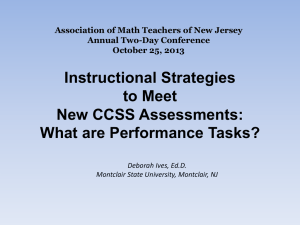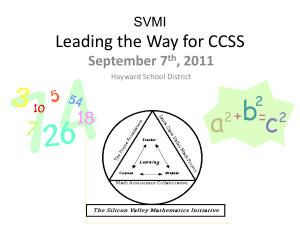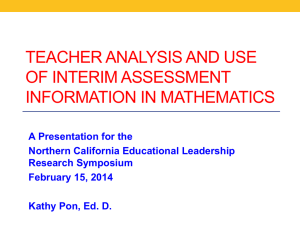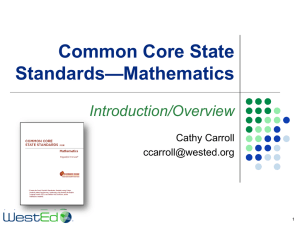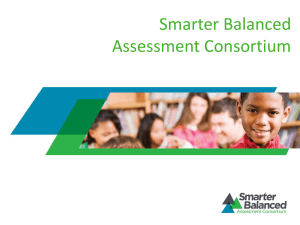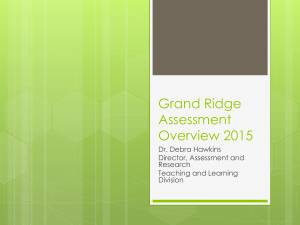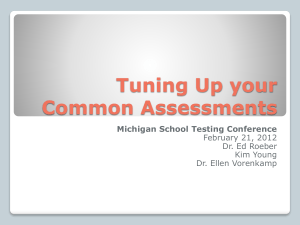Common Core state Standards
advertisement
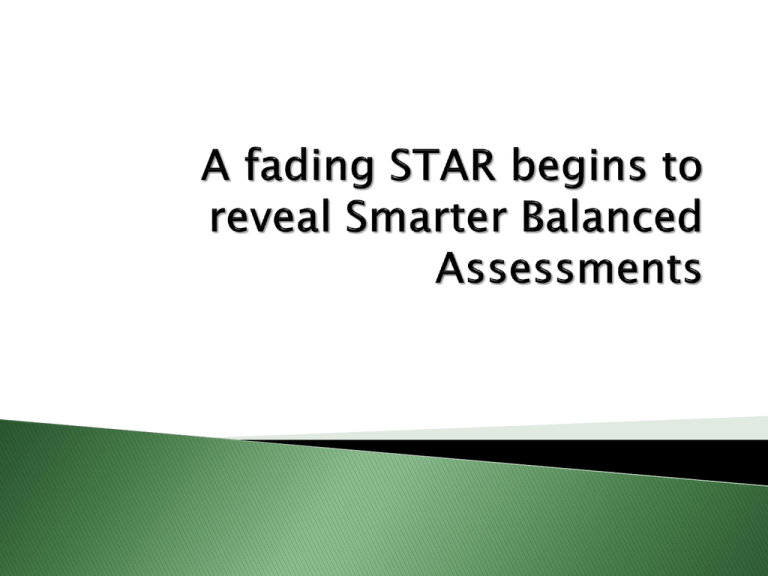
Objective: Discuss some updates from Smarter Balanced Assessment (SBAC) Do Some Math – What will the new assessments look like? 2 Try It! 3 4 5 6 A Schematic Representation of CCSSM Content 3. Construct viable arguments and critique the reasoning of others 4. Model with mathematics 6. Attend to precision 1. Make sense of problems and persevere in solving them 2. Reason abstractly and quantitatively 5. Use appropriate tools strategically 7. Look for and make use of structure 8. Look for and express regularity in repeated reasoning. Reasoning and explaining Modeling and using tools Seeing structure and generalizing Overarching habits of mind of a productive mathematical thinker 8 The Challenge How do we get from here... Common Core State Standards specify K-12 expectations for college and career readiness ...to here? All students leave high school college and career ready ...and what can an assessment system do to help? Susan Gendron A Balanced Assessment System Common Core State Standards specify K-12 expectations for college and career readiness Summative assessments Benchmarked to college and career readiness Teachers and schools have information and tools they need to improve teaching and Teacher resources for learning Interim assessments formative assessment practices to improve instruction All students leave high school college and career ready Flexible, open, used for actionable feedback Susan Gendron A Balanced Assessment System Susan Gendron Using Computer Adaptive Technology for Summative and Interim Assessments Faster results Shorter test length Increased precision Tailored to student ability Greater security Mature technology • Turnaround in weeks compared to months today • Fewer questions compared to fixed form tests • Provides accurate measurements of student growth over time • Item difficulty based on student responses • Larger item banks mean that not all students receive the same questions • GMAT, GRE, COMPASS (ACT), Measures of Academic Progress (MAP) Teacher Involvement TEACHERS PARTICIPATE IN • Test item development • Test scoring • Formative tool development • Professional development cadres TEACHERS BENEFIT FROM • Professional development • Formative tools and processes • Data from summative and interim assessments Assessment System Components Interim Assessment (Computer Adaptive) • Optional comprehensive and content-cluster assessment to help identify specific needs of each student • Can be administered throughout the year • Provides clear examples of expected performance on Common Core standards • Includes a variety of question types: selected response, short constructed response, extended constructed response, technology enhanced, and performance tasks • Aligned to and reported on the same scale as the summative assessments • Fully accessible for instruction and professional development Assessment System Components Summative Assessment (Computer Adaptive) Assesses the full range of Common Core in English language arts and mathematics for students in grades 3–8 and 11 (interim assessments can be used in grades 9 and 10) Measures current student achievement and growth across time, showing progress toward college and career readiness Can be given once or twice a year (mandatory testing window within the last 12 weeks of the instructional year) Includes a variety of question types: selected response, short constructed response, extended constructed response, technology enhanced, and performance tasks Item Exemplars: Technology Enhanced and Constructed Response Susan Gendron Item Exemplars: Technology Enhanced and Constructed Response Susan Gendron Item Exemplars: Technology Enhanced and Constructed Response Susan Gendron Computer-Implemented Constructed Response Task 19 Other similar tasks (not from SBAC): House Numbers problem Candies problems 20 Claim #1: Concepts and Procedures Claim #1 Students can explain and apply mathematical concepts and carry out mathematical procedures with precision and fluency. 40% of the total score in the overall assessment of mathematics Claim #2: Problem Solving Claim #2 Students can solve a range of complex wellposed problems in pure and applied mathematics, making productive use of knowledge and problem solving strategies. 20% of the total score in the overall assessment of mathematics Claim #3: Communicating Reasoning Claim #3 Students can clearly and precisely construct viable arguments to support their own reasoning and to critique the reasoning of others. 20% of the total score in the overall assessment of mathematics Claim #4: Modeling and Data Analysis Claim #4 Students can analyze complex, real-world scenarios and can construct and can use mathematical models to interpret and solve problems. 20% of the total score in the overall assessment of mathematics 25 What Math Content is Needed? Interpreting distance-time graphs in a real-world context Realizing “to the left” is faster Understanding points of intersection in that context (they’re tied at the moment) Interpreting Putting the horizontal line segment all this together in an explanation 26 What Math Content is Needed? 27 Which Mathematical Practices are Utilized? 1. 2. 3. 4. Make sense of problems and persevere in solving them. Reason abstractly and quantitatively. Construct viable arguments… Model with mathematics. 28 Resources www.smarterbalanced.org ◦ Content Specifications with Content Mapping for the Summative Assessment ◦ Appendix C (sample tasks) www.LeaderEd.com ◦ Common Core State Standards Initiative: Classroom Implications for 2014 Daggett and Gendron August 2010 29 Mathematical Practice Rubrics http://bestcase.wordpress.com/2011/ 07/22/mathematical-practices/ ◦ Resources to supplement rubrics implementing mathematical practices 30



